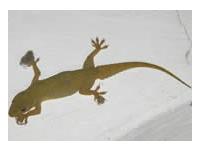
Adult 10-15cms, light to chocolate brown, grey with darker bands.
Eggs (pearly white, rounded) laid by female in cracks and crevices; juveniles undergo several molts (sloughing of skin) before becoming adults.
Commonly seen geckos in India :
Northern House Gecko (Hemidactylus flaviviridis)
Pale grey above, yellowish below. Colour may vary with season. Upto 180mm long, half of which is the tail. The most common gecko of north India found on walls inside buildings; also occurs in some parts of west & central India. Breeds between March-April.
Bark Gecko (Hemidactylus leschenaulti)
Resembles H. flaviviridis, about 166mm long, but with dark grey colour and wavy bands on the back. A common gecko of the Indian peninsula, it is the house gecko in some parts of the country such as Orissa and Bengal. Also frequents trees such as banyan and tamarind, where its colouration helps it to blend in with the bark. Breeds between April-July.
BrookGecko (Hemidactylus brooki)
About 135mm long, with conical tubercles arranged in regular rows on the back; brown or varying shades of grey with brown spots, whitish below. The most common gecko occurring throughout the country, living in a variety of habitats from trees, rocks, under stones and in buildings. Its distinctive, loud chuck chuck chuck call is often heard at dusk. Breeds between April-July.
Southern House Gecko (Hemidactylus frenatus)
About 125mm long, with small granular scales on throat and scattered tubercles on back. The most common house gecko in south India, its call is similar but louder than that of H. brooki, making it perhaps the noisiest Indian gecko. It breeds in the summer months.
Tucktoo (Gecko gecko)
340mm, whitish colour with red-brown spots, tail has banded appearance. The common house gecko of south-east Asia, it is found in Bihar, Bengal and Assam and is the largest among the geckos. Its common name is derived from its loud tuck - too call, which can carry for over 100m. It breeds in the summer months.